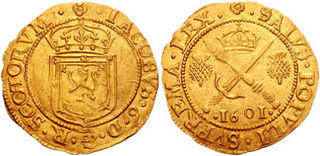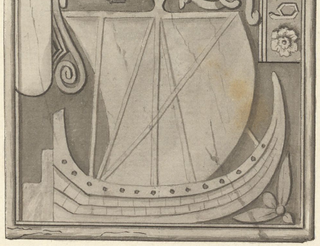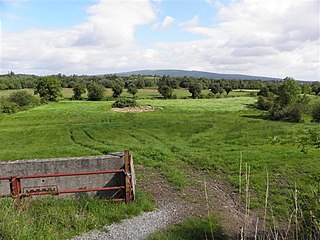Related Research Articles

The acre is a unit of land area used in the imperial and US customary systems. It is traditionally defined as the area of one chain by one furlong, which is exactly equal to 10 square chains, 1⁄640 of a square mile, 4,840 square yards, or 43,560 square feet, and approximately 4,047 m2, or about 40% of a hectare. Based upon the international yard and pound agreement of 1959, an acre may be declared as exactly 4,046.8564224 square metres. The acre is sometimes abbreviated ac but is usually spelled out as the word "acre".
The rod, perch, or pole is a surveyor's tool and unit of length of various historical definitions, often between approximately 3 and 8 meters. In modern US customary units it is defined as 16+1⁄2 US survey feet, equal to exactly 1⁄320 of a surveyor's mile, or a quarter of a surveyor's chain, and is approximately 5.0292 meters. The rod is useful as a unit of length because whole number multiples of it can form one acre of square measure (area). The 'perfect acre' is a rectangular area of 43,560 square feet, bounded by sides 660 feet long and 66 feet wide or, equivalently, 40 rods and 4 rods. An acre is therefore 160 square rods or 10 square chains.

The pound was the currency of Scotland prior to the 1707 Treaty of Union between the Kingdom of Scotland and the Kingdom of England, which created the Kingdom of Great Britain. It was introduced by David I, in the 12th century, on the Carolingian monetary system of a pound divided into 20 shillings, each of 12 pence. The Scottish currency was later devalued relative to sterling by debasement of its coinage. By the time of James III, one pound Scots was valued at five shillings sterling.

The carucate or carrucate was a medieval unit of land area approximating the land a plough team of eight oxen could till in a single annual season. It was known by different regional names and fell under different forms of tax assessment.
A townland is a small geographical division of land, historically and currently used in Ireland and in the Western Isles in Scotland, typically covering 100–500 acres (40–202 ha). The townland system is of Gaelic origin, pre-dating the Norman invasion, and most have names of Irish origin. However, some townland names and boundaries come from Norman manors, plantation divisions, or later creations of the Ordnance Survey. The total number of inhabited townlands in Ireland was 60,679 in 1911. The total number recognised by the Irish Place Names database as of 2014 was 61,098, including uninhabited townlands, mainly small islands.

The birlinn or West Highland galley was a wooden vessel propelled by sail and oar, used extensively in the Hebrides and West Highlands of Scotland from the Middle Ages on. Variants of the name in English and Lowland Scots include "berlin" and "birling". The Gaelic term may derive from the Norse byrðingr, a type of cargo vessel. It has been suggested that a local design lineage might also be traceable to vessels similar to the Broighter-type boat, equipped with oars and a square sail, without the need to assume a specific Viking design influence. It is uncertain, however, whether the Broighter model represents a wooden vessel or a skin-covered boat of the currach type. The majority of scholars emphasise the Viking influence on the birlinn.
The davoch, davach or daugh is an ancient Scottish land measurement. All of these terms are cognate with modern Scottish Gaelic dabhach. The word dabh or damh means an "ox", but dabhach can also refer to a "tub", so may indicate productivity. It was called the arachor in the Lennox.
An ounceland is a traditional Scottish land measurement. It was found in the West Highlands, and Hebrides. In Eastern Scotland, other measuring systems were used instead. It was equivalent to 20 pennylands or one eighth of a markland. Like those measurements, it is based on the rent paid, rather than the actual land area. It was also known as a "tirung", or a dabhach, which is a term of Pictish origin, also used in the east of Scotland too, but for a different measurement. The “ounceland” is thought to be of Norse origin, so it is possible that Norse (‘ounceland’) and native systems (dabhach) were conflated in the west.

An oxgang or bovate is an old land measurement formerly used in Scotland and England as early as the 16th century sometimes referred to as an oxgait. It averaged around 20 English acres, but was based on land fertility and cultivation, and so could be as low as 15.
A pennyland is an old Scottish land measurement. It was found in the West Highlands, and also Galloway, and believed to be of Norse origin. It is frequently found in minor placenames.
A markland or merkland is an old Scottish unit of land measurement.
The Aoghairean of the Hebrides, Scotland, according to Thomas Pennant, were farm servants who had the charge of cultivating a certain portion of land, and of overseeing the cattle it supported. They had grass for two milch cows and six sheep, and also had one tenth sheaf of the produce of the said ground, and as many potatoes as they chose to plant.

Scottish or Scots units of measurement are the weights and measures peculiar to Scotland which were nominally replaced by English units in 1685 but continued to be used in unofficial contexts until at least the late 18th century. The system was based on the ell (length), stone (mass), and boll and firlot (volume). This official system coexisted with local variants, especially for the measurement of land area.
A Scottish or Scots acre was a land measurement used in Scotland. It was standardised in 1661. When the Weights and Measures Act of 1824 was implemented the English System was standardised into the Imperial System and Imperial acres were imposed throughout the United Kingdom, including in Scotland and indeed throughout the British Empire from that point on. However, since then the metric system has come to be used in Scotland, as in the rest of the United Kingdom..
A groatland, also known as a fourpenceland, fourpennyland or “Còta bàn” was a Scottish land measurement. It was so called, because the annual rent paid on it was a Scottish “groat” (coin).

In Scotland a crofting township is a group of agricultural smallholdings holding in common a substantial tract of unimproved upland grazing. Each township comprises a formal legal unit. Like older Scottish land measurements, such as the davoch, quarterland and oxgang, the extent of a township often varies according to the quality of the land it is on, and this can range from a hundred to a few thousand hectares. There is often a substantial tract of unimproved upland common grazing - known as a "shieling" or "àirigh" which is held in common. This tends to be used in the summer, but with the advent of fertilisers it is often used in colder times as well.

The virgate, yardland, or yard of land was an English unit of land. Primarily a measure of tax assessment rather than area, the virgate was usually reckoned as 1⁄4 hide and notionally equal to 30 acres. It was equivalent to two of the Danelaw's oxgangs.
Islay is the southernmost island of the Inner Hebrides of Scotland. Known as "The Queen of the Hebrides", it lies in Argyll just south west of Jura and around 40 kilometres north of the Northern Irish coast. The island's capital is Bowmore where the distinctive round Kilarrow Parish Church and a distillery are located. Port Ellen is the main port.
The water bull, also known as tarbh uisge in Scottish Gaelic, is a mythological Scottish creature similar to the Manx tarroo ushtey. Generally regarded as a nocturnal resident of moorland lochs, it is usually more amiable than its equine counterpart the water horse, but has similar amphibious and shapeshifting abilities.

Boley is a townland in the civil parish of Templeport, County Cavan, Ireland. It lies in the Roman Catholic parish of Templeport and barony of Tullyhaw.
References
- This article incorporates text from Dwelly's [Scottish] Gaelic Dictionary (1911).